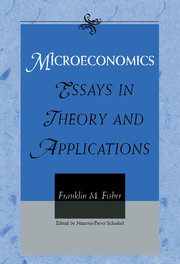Book contents
- Frontmatter
- Contents
- Introduction
- Part I Disequilibrium and Stability
- Part II Welfare Economics and Consumer Theory
- 12 Income Distribution, Value Judgments, and Welfare (1956)
- 13 Income Distribution, Value Judgments, and Welfare: A Correction (1957)
- 14 How Income Ought to Be Distributed: Paradox Lost (1961)
- 15 Advertising and Welfare: Comment (1979)
- 16 Household Equivalence Scales and Interpersonal Comparisons (1987)
- 17 Household Equivalence Scales: Reply (1990)
- 18 Normal Goods and the Expenditure Function (1990)
- Part III Applications of Microeconomic Theory
- Part IV Industrial Organization, Economics, and the Law
- Part V Public Policy Applications
- Epilogue
- Indexes
13 - Income Distribution, Value Judgments, and Welfare: A Correction (1957)
Published online by Cambridge University Press: 20 March 2010
- Frontmatter
- Contents
- Introduction
- Part I Disequilibrium and Stability
- Part II Welfare Economics and Consumer Theory
- 12 Income Distribution, Value Judgments, and Welfare (1956)
- 13 Income Distribution, Value Judgments, and Welfare: A Correction (1957)
- 14 How Income Ought to Be Distributed: Paradox Lost (1961)
- 15 Advertising and Welfare: Comment (1979)
- 16 Household Equivalence Scales and Interpersonal Comparisons (1987)
- 17 Household Equivalence Scales: Reply (1990)
- 18 Normal Goods and the Expenditure Function (1990)
- Part III Applications of Microeconomic Theory
- Part IV Industrial Organization, Economics, and the Law
- Part V Public Policy Applications
- Epilogue
- Indexes
Summary
In “Income Distribution, Value Judgments, and Welfare,” it was assumed that distribution value judgments are independent of the level of total income. We shall show here that no such assumption can be maintained in the multi-commodity case as it either conflicts with the underlying postulate that “welfare is a function of individual utilities” or else implies that all indifference maps are homothetic (indifference curves are radial blow-ups of each other). We shall then point out that the assumption in question can be dropped without changing the major results of the article in other than a formal way.
Adapting the notation of the Appendix, consider a community composed of k individuals and examine a pair of distribution matrices, R(Cm) and R(Cn). These matrices, premultiplied by a given total real income matrix Y(C), will produce two commodity matrices, Cm and Cn. Next, write u(Cm) and u(Cn) to denote the two (1 × k) vectors uj(Cmj) and uj(Cnj) of individual utilities (j = 1, …, k). The postulate that “welfare is a function of individual utilities” implies that:
R(Cm)bR(Cn) If and only if u(Cm)bu(Cn)
that is, one distribution of commodities is to be judged better than another, if and only if the distribution of individual utilities corresponding to the first is judged better than the distribution of individual utilities corresponding to the second. However, it is clear that individual utilities are not simply functions of commodity distributions but also depend upon the level of real income, Cm; and thus u(Cm) is not uniquely determined by R(Cm) but is also a function of Y(C).
- Type
- Chapter
- Information
- MicroeconomicsEssays in Theory and Applications, pp. 227 - 229Publisher: Cambridge University PressPrint publication year: 1999



